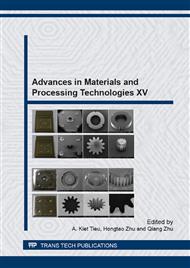[1]
Jurgen Rodel, Alain B.N. Kounga, Marion Weissenberger-Eibl , Daniel Koch , Antje Bierwisch , Wolfgang Rossner , Michael.J, Hoffmann , Robert Danzer, Gerhard Schneider, "Development of a roadmap for advanced ceramics: 2010–2025.", Journal of the European Ceramic Society 29 (2009) 1549–1560
DOI: 10.1016/j.jeurceramsoc.2008.10.015
Google Scholar
[2]
Malkin S.Ritter JE, "Grinding mechanisms and strength degration for ceramics." ASME, Journal of engineering for Industry 1989; 111:2111-18.
Google Scholar
[3]
Rolf Janssen , Sven Scheppokat 1, Nils Claussen "Tailor-made ceramic-based components—Advantages by reactive processing and advanced shaping techniques" Journal of the European Ceramic Society 28 (2008) 1369–1379
DOI: 10.1016/j.jeurceramsoc.2007.12.022
Google Scholar
[4]
Klocke.F., "Modern approaches for the production of ceramic components", Journal of the European Ceramic Society, 17, 1997, p.457–465.
DOI: 10.1016/s0955-2219(96)00163-x
Google Scholar
[5]
Daudin.B, Martin.PN, Mega-electronvolt ion beam polishing of anodically grown alumina, Materials Science and Engineering, 1989; A: 63-66.
DOI: 10.1016/0921-5093(89)90657-6
Google Scholar
[6]
Eckert C, Weatherall J. "Advanced ceramics: 90's global business outlook." Ceramics Industry 1990; 134(4):53–57
Google Scholar
[7]
Rajurkar.K.P, Wang.Z.Y, Kuppattan.A, "Micro removal of ceramic material (AL2O3) in the precision ultrasonic machining.", Precision Engineering 23, 1999, 73-78.
DOI: 10.1016/s0141-6359(98)00026-9
Google Scholar
[8]
Sanchez.J.A, Cabanes.I, Lo´pez de Lacalle.L.N and Lamikiz.A, "Development of Optimum Electro discharge Machining Technology for Advanced Ceramics", Int J Adv Manuf Technol (2001) 18:897–905
DOI: 10.1007/pl00003958
Google Scholar
[9]
Mayer Jr.J.E., Fang G.P., "Effect of grinding parameters on surface finish of ground Ceramics." Annals of the CIRP 44 (1), 1995, 279–282.
DOI: 10.1016/s0007-8506(07)62325-7
Google Scholar
[10]
Huang, H., and Liu Y.C., "Experimental investigations of machining characteristics and removal mechanisms of advanced ceramics in high speed deep grinding." International Journal of Machine Tools and Manufacture 43 (8),2003: 811-823.
DOI: 10.1016/s0890-6955(03)00050-6
Google Scholar
[11]
Bianchi, E. C., P. R. Aguiar, P. R. Aguiar, C. E. da Silva Jr., and C. A. Fortulan. "Advanced ceramics: evaluation of the ground surface." Cerâmica 49 , 2003: 174-177.
DOI: 10.1590/s0366-69132003000300012
Google Scholar
[12]
Mohamed Dabnun.A, Hashmi M.S.J, El-Baradie.M.A, "Surface roughness prediction model by design of experiments for turning machinable glass–ceramic (Macor)", Journal of Materials Processing Technology, 2005, 164–165, 1289–1293.
DOI: 10.1016/j.jmatprotec.2005.02.062
Google Scholar
[13]
Rahaman.M, Senthil Kumar. A, Prakash J.R.S, "Micro milling of pure Copper.", Journal of materials Processing Technology 116(2001) 39-43
DOI: 10.1016/s0924-0136(01)00848-2
Google Scholar
[14]
Takacs.M, Vero.B, Meszaros.I, "Micro milling of metallic materials.", Journal of Materials processing Technology 138(2003) 152-155.
Google Scholar
[15]
Wang, W., S.H. Kweon, and S.H. Yang. "A study on roughness of the micro-end-milled surface produced by a miniatured machine tool." Journal of Materials Processing Technology 162-163, 2005: 702-708.
DOI: 10.1016/j.jmatprotec.2005.02.141
Google Scholar
[16]
Mohan Reddy.M, Alexander Gorin1, K.A. Abou-El-Hossein, "Influence of cutting parameters on Machinable Glass ceramic processed by milling " Advanced Materials Research Vols. 264-265 (2011) pp.825-830.
DOI: 10.4028/www.scientific.net/amr.264-265.825
Google Scholar
[17]
Abou-El-Hossein, K.A., and Z.Yahya. "High-speed end-milling of AISI 304 stainless steels using new geometrically developed carbide inserts." Journal of Materials Processing Technology 162–163, 2005: 596-602
DOI: 10.1016/j.jmatprotec.2005.02.129
Google Scholar
[18]
Alauddin.M, EI Baradie.M.A, Hashmi M.S.J, "Cutting forces in the end milling Inconel 718", Journal of Material Processing Technology 77(1998) 153-159.
DOI: 10.1016/s0924-0136(97)00412-3
Google Scholar
[19]
Suresh Kumar, Reddy.N & P. Venkateswara Rao.P, 2005, "Experimental investigation to study the effect of solid lubricants on cutting forces and surface quality in end milling", International Journal of Machine Tools & Manufacture 46 (2006) 189-198.
DOI: 10.1016/j.ijmachtools.2005.04.008
Google Scholar
[20]
Bernados.P.G, Vosniakos.G.C, "Predicting surface roughness in machining: a review"
Google Scholar
[21]
International Journal of Machine Tools and Manufacture ,43(8) (2003) 833-944.
Google Scholar
[22]
M. Mohan Reddy, Alexander Gorin and K.A. Abou-El-Hossein " Development of Cutting force Model for Aluminum nitride ceramic processed by End Milling" Applied Mechanics and Materials Vols. 87 (2011) pp.223-229.
DOI: 10.4028/www.scientific.net/amm.87.223
Google Scholar


